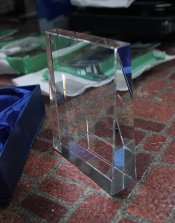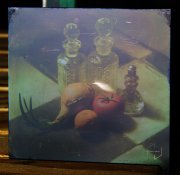Hi everyone,
Here's the big prism update!
Obtaining the prisms
There are two major ways to obtain prisms suitable for Lippmann plates -- make your own, or have them made.
I received several prisms from Nobel Crystal, a Chinese trophy manufacturer. I don't want to get caught by the spam filter, so I'll hold off posting the link. But company can be found on Alibaba, by searching for "crystal wedge awards". Message me if you would like a link to the ad. Make sure you specify all dimensions of the prism (I did not specify the top width, so mine are a tad shallow) and request they not be engraved. Mine cost roughly $13 USD per prism (sized for 4x5 plates), which is dramatically lower than anywhere else I was looking.


Alternately, one can make their own prisms, just like Hologram suggested! Taping up two pieces of glass with duct tape and filling in between them with Eager EP-4101 clear polyester resin (this was at Dr. Hans Bjelkhagen's suggestion), a fairly effective prism can be made for a small price. I should note that these prism's refraction isn't quite as clean as the crystal prism -- looking through, objects are lined with small rainbows. I cannot honestly say I've noticed this at all while viewing a mounted plate. I've made 4x5 and 5x7 sized prisms with this method.

 Mounting the prism
Mounting the prism
I have been using Canada balsam, an optical cement that has been favored through the years due to its index of refraction being very similar to glass. Its advantage over other contemporary optical cements lays in its ability to be heated, in case one wants to swap the plate onto another prism for some reason. The balsam I've been using does not have any extra solvents (it is sometimes sold dissolved in xylene).
In my experience, directly mounting a plate will, without a doubt, blueshift the image. My method of avoiding this blueshift has been to lightly coat the plate with clear matte spray (obtained from any hardware store) 3 - 5 times, allowing the coat to dry for 15 minutes in between coats.
DON'T use a heavy coat -- this will deeply redshift and
RUIN your image! Note: the spray will demolish all reflected color temporarily. The colors will return once the plate is mounted to a prism.
Is a clear acrylic spray archival? I have no idea -- my oldest Lippmann plate using this method is just under 3 months old, with no noticeable signs of degradation. I have a few tintypes from two years ago that were sealed with the same spray, also with no noticeable degradation. Fingers crossed things stay that way!
Canada balsam takes a few days to solidify, and weeks to dry. It is probably best to tape up the sides initially, so the prism won't try to slide out of place. Every few days one can remove a piece of tape, and wipe off extra balsam with acetone. Make sure you have acetone around whenever you work with Canada balsam, the stuff is ridiculously sticky.
















